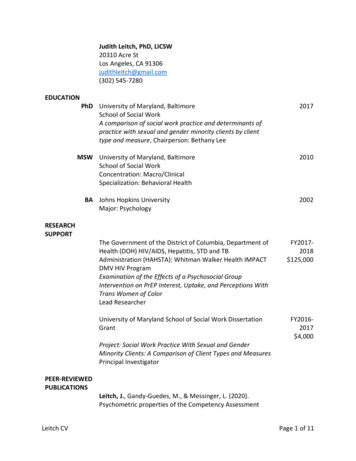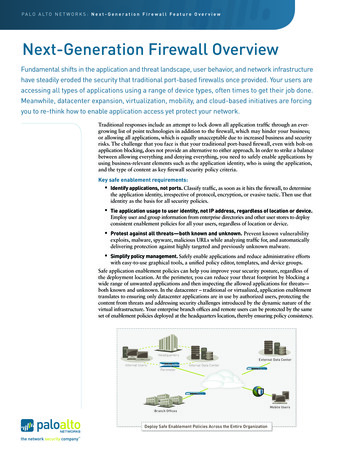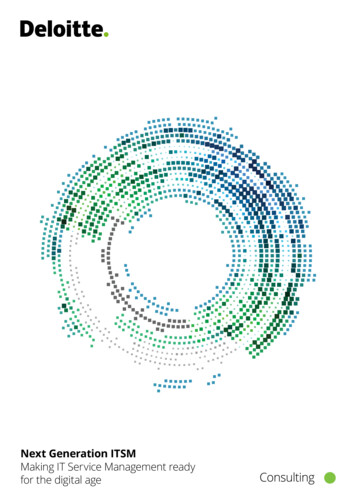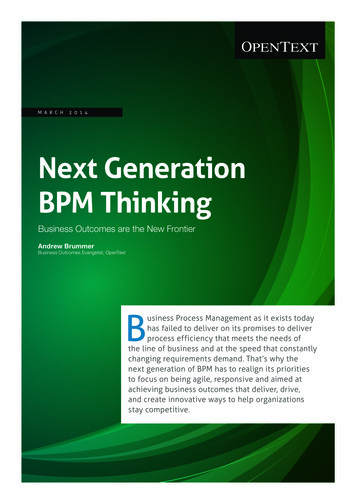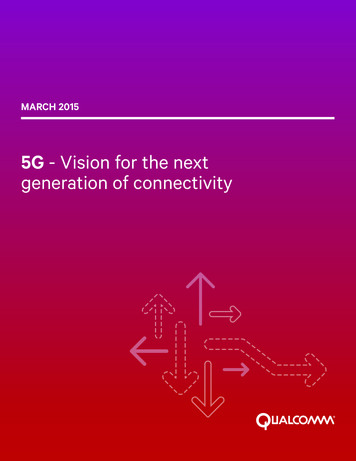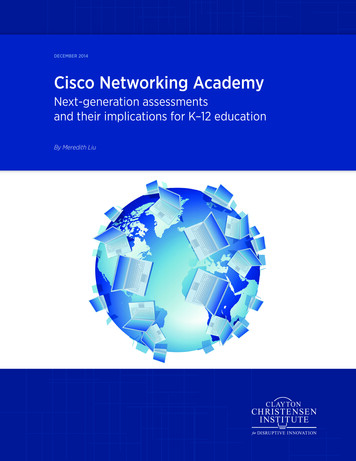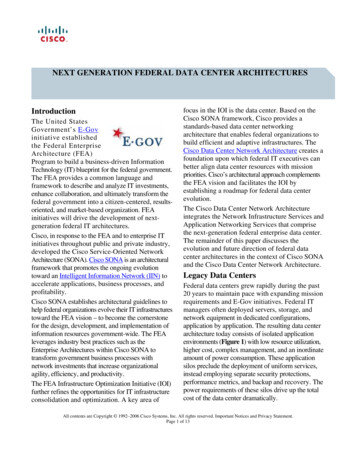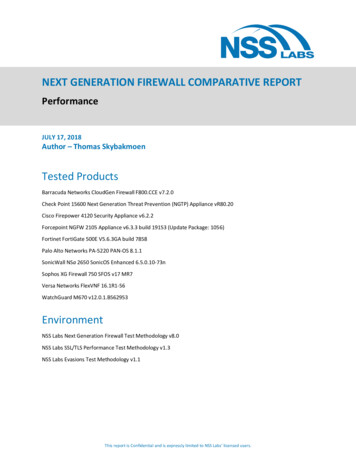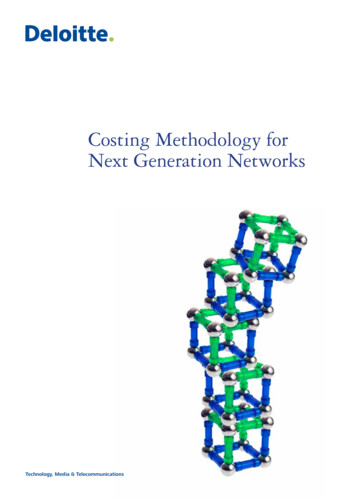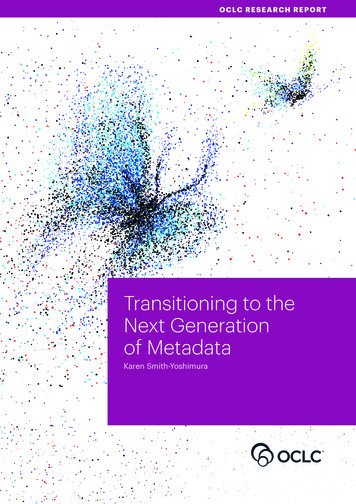
Transcription
FALL 2019Next Generation PhDMeet the new nurse scientistINSIDEFUTURE OF NURSING SCHOLARS 14PhD ON THE CASE 16HELPING SPECIAL PATIENTS 18
FEATURES142“I SAW ANEED ANDWANTED TOACT ON IT.”—TELISA SPIKES18Emory University is an equal opportunity/affirmative action employer fully committedto achieving a diverse workforce and complies with all federal and Georgia state laws,regulations, and executive orders regarding nondiscrimination and affirmative action.Emory University does not discriminate on the basis of race, age, color, religion,national origin or ancestry, gender, disability, veteran status, genetic information,sexual orientation, or gender identity or expression.
IN THIS ISSUE16“PUBLIC HEALTHIS A NATURALCAREER CHOICEFOR NURSES.”— NANCY MCCLUNGFA L L 2 0 1 9Nursing Science’s Vanguard.2Doctoral students tackle the big questionsIn a Class of Their Own.14Meet RWJF’s Future of Nursing ScholarsEpidemiology Sleuth on the Case.16Nancy McClung 15PhD BSN BA RN tracks viruses at the CDCHelping Special Patients.18Amy Blumling 09OX 12N 18G helps bring order to chaosPULSE 20Dean, Nell Hodgson WoodruffSchool of NursingLinda A. McCauley 79MNAssociate Dean and ChiefOperating OfficerJasmine G. HoffmanAssistant Dean forCommunications andMarketingMyra OviattEditorial ContributorsPam AuchmuteyCatherine MorrowSylvia WrobelEditorial ConsultantPam AuchmuteyProduction ManagersCarol PintoStuart TurnerLane HolmanExecutive Director, Editorial,Communications andPublic AffairsArt DirectorKaron SchindlerEditorLinda DobsonDirector of PhotographyStephen NowlandStaff PhotographerKay HintonCreative DirectorPeta WestmaasALUMNI NEWS 28Associate Vice President,Health SciencesCommunicationsVince DollardEmory Nursing is publishedby the Nell Hodgson WoodruffSchool of Nursing (nursing.emory.edu), a component of the WoodruffHealth Sciences Center of EmoryUniversity. 2019.19-SON-COMMS-0517ON THE COVER We photographedRoxana Chicas in a corn field atMitcham Farms in Oxford, Georgia.For info on their products andactivities, visit mitchamfarm.com.
2Emory Nursing EMORYNU R SIN GM AGA Z IN E. EM O RY. EDUIllustration by Stephanie Dalton
aheadCOVERSTORYSTORYCOVERTCURwenty years ago, Emory’s School of Nursing leadership had theforesight to create a doctoral program that would build the ranksof nurse scientists and help address the nursing shortage and thedearth of faculty needed to teach new generations.To mark the PhD’s anniversary, this issue looks at the program’s flourishing growthin research, its students’ and graduates’ novel and creative approaches to nursingscience, and their role in advancing public health and the health care system.In the following pages, you’ll meet a nurse scientist using advanced technology tohelp farmworkers; a recent graduate and postdoctoral researcher asking questionsabout resiliency; and a former children’s minister mining big data for health disparities.They all show the potential impact of PhD work on both individual patients and healthcare as a whole.FA L L 2 0 1 9 Emory Nursing3
ROXANA CHICAS If not you, then who?Roxana Chicas 16BSN RN has a soft spot for blue eye shadow. Hermother wore it the day Chicas, then 4, agreed to leave El Salvadorand return with her to the United States.When her mother initially fled to the U.S. to escape violence targeting women during the SalvadoranCivil War, Chicas was a baby. The 9-month-old remained behind in the care of her grandmother. A fewyears later Chicas’s mother visited El Salvador, and she asked her young daughter if she would like tolive in the U.S. Chicas resisted until the grown-up allure of blue eye shadow swayed her.“If you put makeup on me, I’ll go with you,” Chicas remembers telling her mother. “She whipped outher makeup and put it on me. I left happy, which made my mother and grandmother happy. They didn’twant to force me to leave.”4Emory NursingR SINAGAZ INZIE.NEMEDUE DUEmoryNursing EMORYNUEMORYNURSIGMN GMAGAE . EOMRY.O RY.
COVERSTORYSTORYCOVERRoxana Chicas (left) with herpartner Yesenia Bercian andtheir childrenFALFAL L2 20190 1 9 EmoryEmoryNursingNursing5
TEACHING THE TEACHERS:EMORY’S TATTO PROGRAM SETS UP NURSINGSCIENTISTS TO LEAD IN THE CLASSROOMIf you want an Emory PhD, you mustget a tattoo.All doctoral students go throughthe Teaching Assistant Training andTeaching Opportunity (TATTO—pronounced “tattoo”) Program, administered by the Laney Graduate School,before they can begin dissertation research. “It’s designedto be progressive,” says Associate Dean for AcademicAdvancement Sandra Dunbar PhD RN FAAN FAHA FPCNA.“Students take on increasing responsibilities as they movethrough the program.”According to PhD student Tommy Flynn, “TATTO isa fantastic example of how the School of Nursing andthe Laney Graduate School are very intentional aboutbuilding the right PhD program for each student. It’sone of the ways they help students stay focused ontheir long-term goals.”TATTO consists of four parts; first, a short class thatstudents must take before their first teaching experience.Covering the essentials of postsecondary teaching,it includes writing syllabi, grading, lecturing, leadingdiscussions, and conducting laboratory sessions.Each school within the university manages the threeremaining stages of the program. For the School of Nursing, TATTO’s second stage addresses teaching strategiesspecific to the nursing discipline. Building on the summerclass, it introduces curriculum, instruction methods, stylesof learning, and classroom management. Participants learnabout teaching styles and build a foundation for implementing classroom research.In TATTO’s third stage, students take on a teachingassistantship, a controlled and carefully monitored firstteaching opportunity. Supervising faculty members offerclose guidance and evaluation.Finally, students move into a teaching associateship,another teaching opportunity, but with added responsibility. Often, they co-teach a course, working with a facultymember in all aspects of the class.The TATTO program gives School of NursingPhD students a leg up. Dunbar adds, “Not all PhDnursing programs offer this kind of teacher trainingopportunity. It helps our students be more marketablewhen they’re seeking a position, especially a facultyposition.”—Lane Holman6Emory Nursing EMORYNUR SIN GM AGA Z IN E. EM O RY. EDUThe next day, mother and daughterbegan their long journey, by bus andon foot, to a better life. Some 1,600miles later, they waded across the RioGrande River and entered the U.S.without legal authorization. “My mother carried me on her shoulders,” saysChicas, now 36 and a doctoral candidate at Emory’s School of Nursing.The idea of becoming a nurse,let alone a nurse researcher, neverentered her mind until a few yearsago when a pediatrician named GeraldReisman urged her to aspire beyondher comfort zone.Chicas and her mother settled in theAtlanta suburbs after leaving El Salvador. Some years later, in 2001, PresidentGeorge W. Bush authorized TemporaryProtected Status (TPS) for nationals ofEl Salvador, where two massive earthquakes had created a humanitariancrisis. Chicas became eligible for TPS,which allowed her to obtain a driver’slicense and expanded her job prospectsafter high school. She eventually joinedDunwoody Pediatrics as a billing andreferral coordinator, where she spenta decade assisting Spanish-speakingfamilies and physicians like Reisman,who became her mentor.“I was the unofficial interpreter,which brought me closer to patientsand allowed me to see the dynamicbetween health care and familiescaring for children with chronicconditions,” Chicas says. “The familiesfaced a lot of barriers—access to care,language, culture, and the bureaucracyof health care and insurance andunderstanding what it all means. I wasable to help both the providers andthe patients. I felt fulfilled.”The experience prompted her toconsider becoming a medical assistant.Riesman had another idea—why notbecome a nurse? “That was the first timeI saw myself as a professional,” Chicassays. “I had always thought of myselfas an assistant.”She began taking online courses atGeorgia Perimeter College (GPC) andapplied to its nursing school. But herdream hit a snag when she was deniedadmission because of her TPS, whichmust be renewed every 18 months.Immigration attorney CharlesKuck worked pro bono to help Chicassuccessfully gain admission to nursingschool at GPC, setting a precedent forall TPS applicants.“I worried about what my nursingprofessors would think, and I was determined to do well and earn good grades,”says Chicas. “I got a 96 on my first test.”One day, two Emory School ofNursing professors visited GPC totalk about the new Bridges to theBaccalaureate Program, funded by theNational Institutes of Health (NIH).The program, a partnership betweenEmory and GPC, would prepareminority students for careers in nursingpractice and research. Students wouldmoveto the BSN program at Emory aftercompleting an associate degree at GPC.Interested graduates could then pursuea doctoral degree.Intrigued, Chicas turned to Reismanat Dunwoody Pediatrics for advice. “Ifnot you, then who?” he told her.When Chicas began her BSNstudies at Emory in the spring of2016, she was 33 years old and severalmonths pregnant. She delivered herdaughter between spring and summersemester and graduated cum laude inAugust 2016.Her professors encouraged herto enroll in the fast-track BSN to PhDProgram, intended to produce PhDprepared nurses faster to reduce thenational shortage of nursing scientistsand faculty. She’s had the opportunityto study heat-related illness amongagricultural workers, teach students asa clinical instructor, and advocate onbehalf of Hispanic nursing students,locally and nationally.When Chicas learned she had been
COVER STORYFor Roxana Chicas,preventing heat-relatedillness and death amongfarmworkers is a moralimperative. Here, sheplaces an experimentalcooling vest on a laborerat a farm in NewtonCounty, Georgia.accepted into the PhD program and Dean Linda McCauley would beher adviser, she thought it was a mistake. “I knew about her occupational health research with agricultural workers, but it never crossedmy mind that I would work with the dean,” she says. “My peers alreadyhad a defined research question. I didn’t have a research question yet.”When they met, the dean assured Chicas that her question wouldevolve as she learned the dynamics of working on a research teamand how to approach problems scientifically to identify and fillknowledge gaps.“The dean made me feel comfortable right away,” says Chicas. “Shetook me on as her student, knowing I couldn’t get NIH funding becauseI don’t hold a Green Card. I could be a collaborator regardless. We talka lot about equity in the nursing school. The school and the dean mademe feel equal.”After delving into the program, Chicas developed her research question: What type of heat interventions can agricultural workers use whileworking in the field to maintain their body temperature at the recommended threshold of 38 degrees Celsius (100.4 degrees Fahrenheit)?She conducted a pilot study to test two interventions—a coolingbandana and cooling vest—on Florida farmworkers. Only two similarstudies had previously been conducted worldwide, one of them ina simulation lab. Chicas is in the midst of analyzing her data andwriting her dissertation.“It was important to test these interventions in the field to seeif workers will wear them, whether they interfere with their workefficiency, and whether the vests keep their temperature under thethreshold,” says Chicas.“If their temperature is above 38 degrees Celsius, they are workingwith a fever, even though they don’t have an infection,” she continues.“Their symptoms are like those that accompany a fever—body aches,headaches, dizziness, and nausea. And they are more likely to die ofheat-related illness. To suffer or die from something preventable is areflection of the failure of society to protect its vulnerable workers.”Four organizations funded her research, including the NationalAssociation of Hispanic Nurses (NAHN), which holds special meaningfor Chicas. Her Aguilar-Cuellar-Toben PhD Dissertation Grant Award isa first-time award for NAHN and the first time it has been given to anundocumented resident. Until this year, NAHN criteria stipulated thatscholarship recipients had to be a U.S. citizen or hold a Green Card.In November, the Georgia chapter of NAHN will cohost a youthleadership conference with the Latin American Association at Emory.The conference will bring Hispanic middle and high school students toEmory to learn what the university has to offer. Some attendees are likelyto be first-generation college students like Chicas.Upon learning this year’s conference would be held at Emory,she suggested the school promote nursing as a profession.“I didn’t know that I could be a nurse when I was younger,”says Chicas, who is raising two boys from El Salvador and herdaughter while keeping an eye on a federal court case that couldrevoke TPS for El Salvador residents. “We need to start putting thatspark in students to let them know they can be nurses or any otherprofessional. We need to let them see nurses who are building aminority workforce that represents the Hispanic population in theUnited States.” —Pam AuchmuteyFA L L 2 0 1 9 Emory Nursing7
TELISA SPIKES I saw a need andwanted to act on it.As a nurse manager of a health failure/postopen-heart surgery unit, Telisa Spikes19PhD RN was puzzled by the number ofyoung black women diagnosed with heart failure.Why so many, she asked herself, and why so young? After shewatched a 29-year-old mother of three die of advanced heartfailure, Spikes turned to research to get some answers. Fiveyears ago, she entered Emory’s nursing PhD program, workingwith research mentor Sandra Dunbar PhD RN FAAN FAHAFPCNA, professor and senior associate dean for academicadvancement, “who really pushed and stretched me.” Spikesloved it. Her NIH-funded dissertation focused on facilitatorsof adherence to hypertension medications. Her mostsurprising finding? Women who believed their hypertensionwas less serious were more likely to follow through with theirmedication regimen than women who believed the conditionwas more serious.“My PhD education provided me astonishing amountsof knowledge and research skills,” says Spikes, “but I knewI wanted to gain even more skills.”That meant a postdoc. This fall, the new nursing PhDwill begin a two-year postdoctoral program in epidemiologyat Rollins School of Public Health. She is formulating newresearch questions about resiliency and how coping behaviorscould serve as a buffer against disease-related stressors likepoverty, racism, and living in high-crime neighborhoods.The position is funded by a T32 research training grant fromthe NIH. Her long-term goal is to join a research institution,using her postdoctoral findings to investigate interventionsfor African Americans, both male and female, with or at riskfor heart disease.“I saw a need, and I wanted to act on it,” says Spikes.“Emory’s doctoral and postdoctoral programs are helpingme do that.”—Sylvia Wrobel8EmoryNursing EMORYNUEMORYNUR SIGMN GMAGAE . EOMRY.O RY.Emory NursingR SINAGAZ INZIE.NEMEDUE DU
COVER STORYIN HER OWN WORDS: SARAHFEBRES-CORDERO 17BSN ANDTHE PHD PROGRAM“When I think of resilience,especially in the lives ofAfricans Americans, it’scentered around faith.Here in Atlanta, nothingsymbolizes this more thanEbenezer Baptist Church”says Telisa Spikes.I was a server and managerat Savage Pizza in Little FivePoints for 20 years beforedeciding to become a nurse.I watched for many years ascommunity members struggledwith homelessness, hunger,and safety. I saw many people with drug and alcoholdependence and occasionally witnessed an overdose.While I did whatever I could—making sure none of ourleftover food went to waste, keeping extra clothesand blankets in my car, and occasionally handing outcash—I felt frustrated and underequipped to help ina meaningful way.Eventually, I decided to take real action and finda way to contribute to my neighborhood. Nursingseemed the obvious choice, and in 2014 I started myAssociates of Science in Nursing at Georgia PerimeterCollege. While there, I was introduced to the Bridgesto the Baccalaureate Program (BttB).The Bridges program offered a unique opportunityto expand my knowledge of nursing science. Throughthe program, we were to attend Emory in the summerswith the expectation that we would learn the skillsnecessary to become competitive applicants for thePhD in nursing program. In addition to courses onnursing research, we were also to seek out mentorshipwithin the School of Nursing. Mentorship in the BttBwas incredible. Professor Kate Yeager 12PhD RN FAANand others were very influential. We were exposedto the School of Nursing’s research and had small,intimate classes conducted by Professor Jessica Wells12PhD RN WHNP-BC.Additionally, we were chaperoned by Cynthia Payneand Contessar Maddox of GPC. I clearly rememberCynthia Payne saying we had “won the nursing lottery”and that this was a-once-in-a lifetime opportunity.CONTINUE TO NEXT PAGEFA L L 2 0 1 9 Emory Nursing9
As great an opportunity as the BttB was, it took a considerable shiftin thinking about the field of nursing. Originally, I planned to become abedside nurse. The PhD program was a huge opportunity, but it meant Ihad to rethink my role as a nurse.I had mixed feelings about going straight to the PhD from the BSN.Many of the mentors in my program insisted that it is not necessary towork at the bedside before training in nursing science, as the skill set isnot the same. Not everyone agrees, and I believe this is mainly becausenurses who worked in the field first were thought to have a more preciseunderstanding of needs within theclinical population.I admit that while in the BttB, Ihad my doubts about whether thepath from BSN to PhD made sense.However, now that I am two yearsinto the PhD program, I agreewith Ms. Payne. I won the nursinglottery. Attending Emory has beenthe most enormous privilege ofmy life. This is the first time I’vehad so many women mentors toSarah Febres-Corderolook up to, I have received a stellareducation, and I have had the time to figure out what kind of nurse I amand what sort of nurse scientist I want to be.It is not uncommon for students to begin nursing school not knowingwhich part of health care they wish to work in. I was no different. I had manyinterests but wasn’t sure where I belonged in health care. My original goalwas only to get a job and find my way from there.As a School of Nursing student, I have come to realize thatI am a public health nurse who wishes to contribute to nursing sciencein harm reduction. I am committed to working with communities toreduce harms associated with drug use. As a trained nurse scientist,I can use my skills to develop interventions by using communitybased participatory research. This will be the focus of my dissertationresearch—I will return to Little Five Points to evaluate the currentunderstanding of overdose identification and Narcan distribution anduse to save lives in the wake of the ongoing opioid epidemic.Thanks to the BttB, Georgia Perimeter College, and Emory, I wasgiven the time to learn, train, and think about my role as a nurse outin the world.Since coming to the School of Nursing, I have been a researchassistant, a research coordinator, a nursing simulation lab instructor,and a volunteer nurse in the community. Soon, I will be volunteeringwith the Atlanta Harms Reduction Coalition.I am confident that the training I receive here will be of immensevalue. I am excited to work in harms reduction for my dissertation andhope to continue to contribute as a public health nurse scientist formany years.—Sarah Febres-Cordero 17BSN10Emory Nursing EMORYN UR SIN GM AGA Z IN E. EM O RY. EDUTOMMY FLYNN The world needsproblem solvers.“I got into nursing to h
Nursing professors visited GPC to talk about the new Bridges to the Baccalaureate Program, funded by the National Institutes of Health (NIH). The program, a partnership between Emory and GPC, would prepare minority students for careers in nursing practice and research. Students wou
